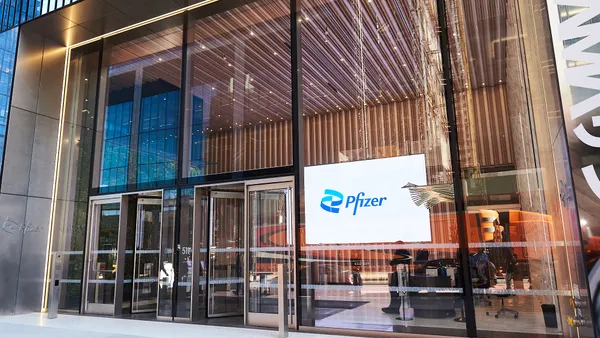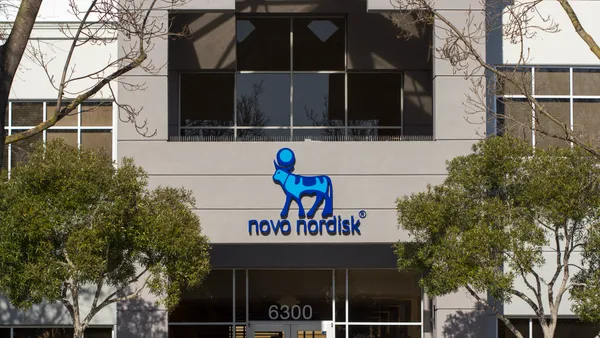Managed MARKETS
Managed care organizations are tackling the rising costs and expanding use of specialty products. Specialty drugs, injectable biologics, and other highercost drugs that require close supervision and monitoring are the fastest growing segment of the overall pharmaceutical space. The average annual increase in drug cost expenditures reported in 2007 was 6.9%,accord ing to the Pharmacy Benefit Management Insti tute’s (PBMI) 2007 Prescription Drug Benefit Cost and Plan Design Report released in October 2007. Experts say specialty drug costs as a whole are rising faster than nonspecialty drugs. For example,at PrimeTherapeutics,a pharmacy ben efit manager, specialty drugs accounted for 13.8% of clients’drug spending in 2006.The most dramatic increase in specialty drugs was in the oncology market. At Express Scripts, spending on highcost biotech drugs increased 21% in 2006. This increase excludes spending for biotech drugs within the medical benefit, such as those admin istered in physicians’ offices or other therapies that traditionally fall into the medical benefit.The company estimates overall biotech drug costs will reach $99billion by2010,accounting for 26% of total drug spending. “In 2006,specialty drugs accounted for about 20%of the market,or $54 billion of a total market of about $275 billion,” says Tony Lanzone, VP, trade and distribution practice, at Campbell Alliance.“In 2010, the specialty market is expect ed to be just under a $100 billion. Furthermore, the specialty market is anticipated to double in a couple of years, while the nonspecialty spend in 2010 is projected to be $284 billion.” Certain drug classes, such as arthritis, oncolo gy, and multiple sclerosis, are growing tremen dously in terms of utilization, says Michael Jacobs, national clinical practice leader at Buck Consultants. (See related box on page 72.) Specialty drugs generally encompass a cate gory that contains genetically engineered, injectable therapies with costs greatly exceeding those of most traditional therapies, and address a number of complicated con ditions, including osteoporo sis, arthritis, multiple sclero sis, and cancer. The Centers for Medicare & Medicaid Services now informally defines specialty drugs as those regularly cost ing $500ormore for a30day supply. These are highercost products for a number of reasons, Mr.Lanzone says. “These drugs require spe cial handling and special instructions in terms of administration,” he says.“The therapeutic categories that are driving specialty pharma cy growth include: multiple sclerosis, cancer, blood cell deficiency,growth hormone products, and inflammatory conditions such as rheuma toid arthritis.” According to The Segal Company, the 2008 projected trend for specialty drugs is 19.5%, almost 10 percentage points above aggregate retail trend. This is significant because specialty pharmaceuticals account for 17.1% of the total drug trend. The high cost and trenddriving impact of these drugs will continue to be felt in the coming years as research and new drug approvals continue. SPECIALTY NETWORKS PBMs and managed care organizations are trying to control specialty drug usage by bring ing highcost injectables that were formerly cov ered under the medical benefit — especially those that are selfadministered — under the pharmacy benefit, says Michael Goodman,VP of research products at AVOS Life Sciences. “This gives managed care organizations a powerful lever for controlling drug utilization,” Mr. Goodman says. “And if there are alternatives, the MCOs are obviously going to channel some patients to cheaper alternatives.” A Pharmacy Benefit Management Institute report states that 30% to 60% of specialty drugs are included under the pharmacy program. The report also found that 75% of employers offer a specialty pharmacy benefit. Slightly more than half — 51.5% of employers — require specialty drugs reimbursed under the drug benefit to be dispensed by the pharmacy benefit manager’s designated pharmacy. “There is greater insight and transparency of drug utilization for products covered under the pharmacy benefit based on current system func tionality and data availability,” Mr. Lanzone says. “This transparency allows payers to provide greater oversight of utilization for products cov ered on the pharmacy benefit versus if the prod ucts were bundled in the medical benefit.This is a trend worth watching based on the informa tion from the health plan decision makers with whomwe’ve spoken.” Mr. Jacobs says other companies are using SPECIALTY DRUGSANDBIOLOGICSARECOMINGUNDERTHE SAME SCRUTINY ASOTHERPRESCRIPTIONDRUGS. BY DENISE MYSHKO MICHAEL GOODMAN AVOS LIFE SCIENCES In recent years, injectable and officeadministered biologic drugs are being put on formularies. TONY LANZONE CAMPBELL ALLIANCE By strategically partnering with selected specialty pharmacy providers, pharma and biotech companies are able to address their objectives and strategies in a much more focused fashion. PV0308 LAYOUT 2/14/08 5:43 PM Page 70 Managed MARKETS services when it acquired PolyMedica,a provider of diabetes care and treatments. More recently, in January 2008, Medco received URAC’s Drug Therapy Management (DTM) Accreditation for its clinical management program, which provides patients with access to specialist pharmacists trained in specific chronic and complex conditions. Medco completed the rollout of the Medco Therapeutic Resource Cen ters last year, culminating three years of develop ment and the process of training specialist pharma cists in specific chronic and complex conditions. Mr. Jacobs says using a specialty distribution net work can be positive for the PBM. “PBMs collect all the data so they bill the drug under the NDC,” he says. “There is a guaranteed price that is paid up front. By having the data go through the pharmacy benefit manager, there is a very clear idea of what specialty product was given, what dose, what size. And there is a hard figure on price plus a discount. On the physician side, a company doesn’t know any of that infor mation,which then can’t be managedor tracked. Thedataareput into reports and the information is shared with the employer or the managed care organization; the PBM can then either negotiate for better pricing or rebates from the manufac turer.” IS IT ALL BADNEWS? AnApril 2007 report from Express Scripts pre dicted that specialty drug utilization was going to slow in the next couple of years because of lower than historical growth in a few therapeutic categories. In the inflammatory conditions class, market expansion beyond the treatment of rheumatoid arthritis (RA) has leveled off — leading to a slow down in the explosive growth since 1998. That deceleration is expected to continue even as new products are approved. Slower growth also is expected in the blood cell deficiencies category because several recent clinical studies have reported safety issues with the use of erythropoietin (EPO).Toward the end of the decade, utilization growth will be fueled specialty distribution networks as a way to con trol costs. “They are trying to switch as many drugs as they can out of the retail network and into their own specialty distribution channels,” he says. “They’re trying to switch drugs from a mail ser vice,which has deep discounts, into specialty dis tribution, which has fewer deep discounts. And they’re selling it under the guise that they are going to help manage uti lization.” The largest of the PBMs — Medco Health Solu tions, Express Scripts, and CVS Caremark — all have their own specialty net works. Medco, for example, has made efforts over the last few years to address the specialty pharmacy market. In 2005,Medco completed its acquisition of Accredo Health, a company that provides pharmacy and related services for the treatment of patients with certain costly,chronic diseases. In 2007, Medco added to the company’s specialty THETOPSIXSPECIALTYCATEGORIES 1 Inflammatory Conditions 2Multiple Sclerosis 3Cancer 4 Blood Cell Deficiency 5Growth Deficiency 6Hepatitis C PV0308 LAYOUT 2/14/08 5:43 PM Page 71 ExL Pharma,a division of ExL Events, Inc., is anemerg ing leader in developing innovative, educational events that serve the healthcare community and allied professionals. Behind our diverse conference portfolio, our experienced team conducts extensive market research and targeted outreach. The results translate into innovative, highquality conference events designed to exceed the dynamic information al needs of the healthcare community. We’ve Moved! Our New Address is: 555 8th Ave Suite 310 New York, NY 10018 Facing The Challenges of Delivering RNAiBased Therapeutics March 6, 2008 Webinar, Online Latin America Clinical Trials March 10, 2008 to March 11, 2008 Hyatt Regency Miami, Miami, FL Integrated eLaboratory March 18, 2008 Webinar, Online BehindtheCounter Drug Designation March 20, 2008 Webinar, Online 2nd Annual Investigator Relationship Management March 25, 2008 to March 26, 2008 Loews Philadelphia Hotel, Philadelphia, PA Wireless Pharma April 14, 2008 to April 15, 2008 Doubletree Hotel Philadelphia, Philadelphia, PA HR for Pharma April 28, 2008 to April 29, 2008 Hollywood Beach Marriott, Hollywood, FL 2nd Clinical Supply Forecasting Summit April 28, 2008 to April 29, 2008 Loews Philadelphia Hotel, Philadelphia, PA A Medical A#airs Leadership Conference May 1, 2008 to May 2, 2008 Bridgewater Marriott, Bridgewater, NJ 3rd Annual Integrated Relationship Marketing and Sales for Pharma May 5, 2008 to May 7, 2008 Sheraton University City Hotel, Philadelphia, PA MARK YOUR CALENDARS FOR EXL PHARMA’S UPCOMING CONFERENCES TO REGISTER CALL 8662076528 OR VISIT WWW.EXLPHARMA.COM When Registering, Please Use Registration/Priority Code: EXLPVAD Supporting Partner 72 M a r c h 200 8 PharmaVOICE by new products that are expected to be approved in 2008 and 2009 for multiple sclerosis and hepatitis C, as well as combination cancer therapies. Costperprescription growth will be damp ened slightly by less expensive growth hormone products approved in 2007 and by true generic anticoagulants that should enter the market within the next few years. Additional downward pressure may be exerted by new oral medica tions for conditions such as MS,currently treated only by injectables. Experts say pharmaceutical manufacturers will encounter greater cost pressure and demand for outcomes data in their negotiations with managed care organizations,and specialists will gain prescribing control. Rebates andprice discounts, industry analysts say, will not be as effective in securing preferred formulary placement for novelacting biological agents as they are for conventional primarycare drugs, where utilization volume is so much greater and can translate into significant savings for the plan. A key lever in negotiating preferred formula ry placement for specialty products will be the quality of the data behind the product and the clinical guidelines governing its use, particularly as therapeutic categories fill up with more treat ment options. “Companies that want to succeed in the spe cialty market have to understand the needs of the specialist and form equity relationships with key opinion leader specialists early on, during discovery,”Mr.Goodman says.“This is a very com plex and rich relationship, unlike anything in the primary care world.” Mr. Lanzone suggests that pharmaceutical companies need to systematically evaluate part nership opportunities and requirements with specialty pharmacy companies. “A best practice is for pharmaorbiotech com panies to clearly define their objectives and strategies for each brand and then partner with the type of specialty pharmacy provider that is best able to deliver the services required to opti mally position their product to physicians and patients,”Mr. Lanzone says. # PharmaVOICE welcomes comments about this article.Email us at [email protected]. Managed MARKETS MICHAEL GOODMAN.VP,Research Products,AVOS Life Sciences, Raleigh, N.C.; AVOS Life Sciences is a boutique advisory and research products company.For more information, visit avoslifesciences.com. MICHAEL JACOBS. National Clinical Practice Leader, Buck Consultants LLC, NewYork;Buck Consultants provides human resource and benefits consulting through more than 1,500 professionals worldwide.For more information, visit buckconsultants.com. TONY LANZONE.VP,Trade and Distribution Practice, Campbell Alliance, Raleigh, N.C.; Campbell Alliance is a management consulting firm specializing in the pharmaceutical and biotechnology industries. For more information, visit campbellalliance.com. Experts on this topic 2007TO 2010 FORECAST FOR SELECTED SPECIALTYTHERAPY CLASSES 2006 THERAPY 2007 2008 2009 2010 COMMENTS RANK CLASS 1 Inflammatory 21.9% 21.9% 21.9% 21.9% Conditions 2 Multiple 16.2% 16.3% 16.4% 15.4% Sclerosis 5 Growth 5.0% 10.2% 9.2% 9.2% 6 Hepatitis C (0.3%) (0.3%) 12.4% 14.5% 7 Other 24.2% 25.4% 26.5% 26.5% Total 21.2% 22.0% 23.5% 24.0% 4 Blood Cell 5.0% 6.1% 7.1% 7.1% 3 Cancer 43.8% 38.0% 38.0% 38.0% Source:Express Scripts 2006 DrugTrend Report,St.Louis.For more information,visit expressscripts.com. TREND New products such as Cimzia and new indications for existing drugs will continue to drive increases in utilization. Inflation will drive cost due to no new followon generics and little competition among brands. New oral brands,which are expected in 2008 and 2009,may increase utilization but decrease cost/Rx. Drugs currently used to treat cancer may be approved for MS — potentially reducing the use of existing MS drugs. New drugs and combination therapy will drive up utilization. Less growth is expected in utilization,primarily driven by recently publicized safety concerns associated with the use of EPOproducts for anemia. Omnitrope,a less expensive followon protein launched in January 2007,will reduce 2007’s cost/Rx.After 2007,expect slightly slower growth in utilization and a return to consistent inflationary cost/Rx increases. Current medications are not effective for all patients,and no new therapies have been introduced.New products expected in 2009 and beyond are likely to increase utilization.The introduction of generic ribavirin continues to impact cost/Rx. Other specialty categories are expected to experience slightly higher than historical growth as new products are introduced for previously untreated or undertreated conditions.Biogenerics in some categories should help to slow overall growth in cost. PV0308 LAYOUT 2/14/08 5:43 PM Page 72









